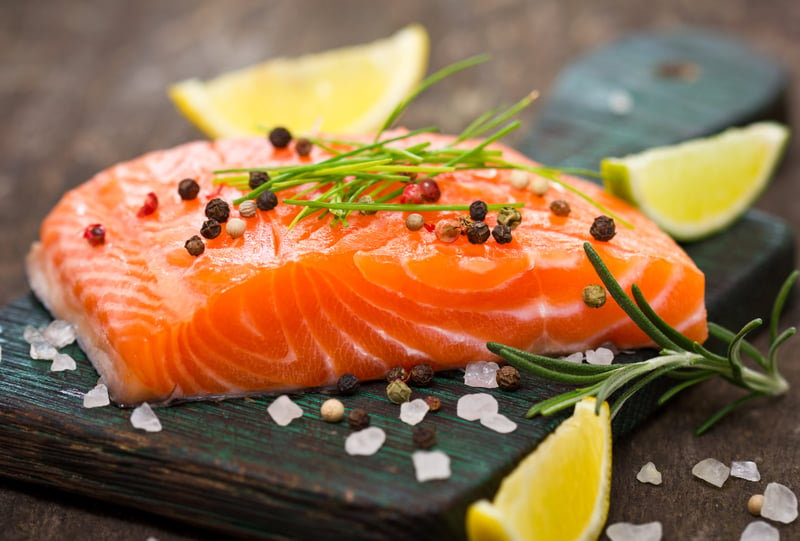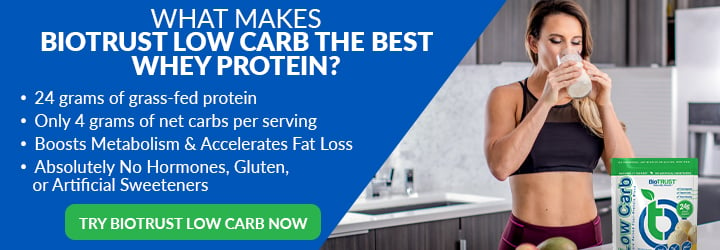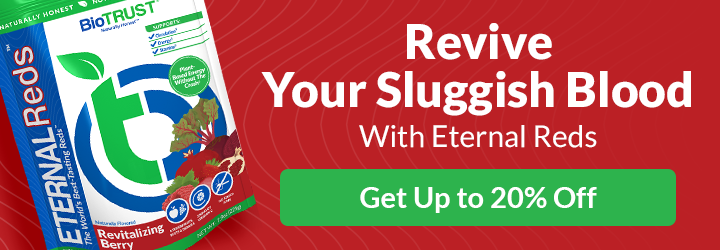The Best Muscle-Building Foods (not named chicken)

Contrary to popular belief, it’s not only bodybuilders and teenagers who want (or need) to put on muscle. Maintaining or, better yet, gaining muscle mass is vital for healthy aging. Losing muscle mass—a common issue as we age—can lead to weakness and decreased mobility. This can mean we’re more likely to fall and get injured. Maintaining that muscle could prevent a broken hip, leg, wrist, or arm. Not to mention, sculpting lean muscle is also the best way to change the shape of the body—helping build a better booty, for example, or tone and shape to the arms and legs.
Most people already know there’s a connection between building muscle mass and protein. Yet ensuring you have the building blocks for muscle doesn’t mean living off traditional bodybuilding foods like chicken breasts, tuna, or eggs. There are so many good muscle-building foods out there!
Of course, protein is vital to building and maintaining muscle mass. When protein is consumed, the body breaks it down into amino acids—the building blocks of muscle. And the older we get, the more protein we need.
How much protein? Recent research suggests a daily protein intake of at least 1 to 1.3 grams of protein per kilogram of body weight is needed for adults who resistance train. So, a 160-pound woman would need at least 73 to 94 grams of protein per day, and a 185-pound man would need at least 84 to 109 grams of protein per day. 1
Protein, however, isn’t the only nutrient needed to build muscle. A variety of nutrients—including iron, magnesium, and Vitamin D, to name just a few—are needed to fuel the muscles into growth.
The 13 Best Muscle-Building Foods
Here are some of our favorite muscle-building foods to include, along with why they’re on this list:
1. Salmon
One of the top muscle-building foods is salmon. This fish is superior in terms of quality proteins (17 grams) and omega-3 fats (2 grams), which have important roles in muscle health, repair, and growth. Salmon is also rich in several B vitamins, selenium, vitamin D, and niacin.
If you aren’t that into the flavor of fish, you may want to play with how you prepare it: try it blackened, in fish tacos, or in salmon cakes. You may be surprised by how delicious this firm yet mild fish can be with just a bit of experimentation.
2. Shrimp
Want a good dose of protein without a lot of calories, fat, or carbs? Shrimp is pretty much just protein, including the muscle-building amino acid leucine. For a meal that’s low-carb, low-calorie, yet decadently delicious and loaded with protein, you can’t go wrong with this Tequila Lime Shrimp with Zoodles.
3. Whey Protein Powders
Perhaps the easiest, most convenient way to ensure you’re getting enough quality proteins is simply by using a high-quality whey protein powder. If you’re on the go, you can simply toss your protein powder into a shaker bottle with your favorite liquid (e.g., water, almond milk, or cow’s milk), shake, and drink. If you have a bit more time or are looking for a complete meal replacement, you can also add fresh or frozen fruits, nuts or seeds, veggies like spinach or kale, and even some spices like cinnamon, cardamom, cloves, etc.
4. Greek Yogurt
Looking for something smooth, creamy, rich, and muscle-building? Then Greek yogurt may be the one for you. Greek yogurt is loaded with nutrients to build muscle, including protein, calcium, and vitamin D. Sugar, on the other hand, isn’t so good for muscle building, so skip the sugar-loaded versions and go for plain instead. You can always add your own fresh or frozen fruit. Or, perhaps, stir in your favorite protein powder for some flavor and sprinkle with some oatmeal, granola, nuts, or sliced fruit. You could also reverse that and top your oatmeal with a dollop of Greek yogurt for a nice, creamy flavor.
What if you prefer other forms of yogurt? Go for it. All yogurts provide a mix of fast- and slow-digesting proteins to help with workout recovery. However, it’s worth mentioning that Greek yogurt provides about twice as much protein as many other yogurt varieties.
5. Chia Seeds
These seeds from the Aztec civilization provide a big nutritional punch in a tiny package. One tablespoon of chia seeds is loaded with essential amino acids (3 grams of complete protein), omega-3 fats (namely alpha-linolenic acid or ALA), and fiber (5 grams). Plus, it also provides muscle-building nutrients like iron, calcium, magnesium, and manganese.
6. Hemp Seeds or Hearts
Another plant food that’s surprisingly high in the essential amino acids needed for muscle growth is hemp. The seeds or hearts provide up to 11 grams in a 3-tablespoon serving. You can add whole hemp seeds to a salad, smoothie bowl, or even in soup or chili. If you are looking for a vegan protein powder, ones that include hemp seed powder are also good options.
BREAKING: Forget Taking Collagen, Try This 21-Second Trick for Healthier Skin & Hair Instead
7. Beans and Legumes
Another easy-to-prepare, plant-based muscle-building foods are beans, legumes, and lentils of every style. They all are nutrient powerhouses that provide protein, fiber, complex carbs, and nutrients like folate and copper. What’s more, research has found that eating around ¾ cups of beans and legumes daily can increase weight loss and help keep it off, so you can better show off the muscles you’ve built in the gym. 2 Of course, you can easily add beans to salads, soups, and burritos, but beans are another very versatile food that can even be added to desserts and muffins.
8. Sweet Potatoes
Healthy, full of flavor, and surprisingly versatile, sweet potatoes have long found their way onto typical “bodybuilder” plates. This is because these sweet treats are high in fiber (4 grams) and slow carbs and, just as importantly, vitamin A. Vitamin A, in turn, helps the body synthesize protein. Of course, you can bake sweet potatoes, but they also work well in soups and chilis, or baked for sweet potato “fries.”
9. Beets
This lowly, neglected vegetable is often picked last due to its unusual looks and earthy taste. But when it comes to muscle building, beets pack quite a punch. They’re rich in iron and have been shown to boost blood flow to help improve muscle recovery. They can also be quite tasty when roasted with a drizzle of olive oil. Beet juices are also gaining in popularity due to their favorable effects on blood circulation.
10. Kale
While this hyped-up dark leafy green does provide some protein, it’s on the list because it provides the muscle-building nutrients iron and vitamin K. Iron is needed by the body to both oxygenate the muscles and help them repair after a tough workout. It may help you push harder during your workout, too, as it provides nutrients that increase endurance. And vitamin K helps the body keep inflammation in check and helps keep the joints moving smoothly.
11. Mushrooms
Strength and muscle mass are directly linked. And one key indicator of strength is vitamin D levels, according to a recent study in Medicine & Science in Sports and Exercise. 3 That is, the participants in the study with higher levels of vitamin D were also stronger. Other studies have had similar findings. That brings us to mushrooms, which are the #1 vegetable food source of vitamin D. For the greatest amount of D for your buck, look for maitake (Hen of the Woods), which provides three times more than the DV for D, or chanterelle, morel, or shiitake.
12. Millet
This gluten-free grain-like seed may not be as popular as quinoa, but when it comes to muscle-building, it should not be overlooked. Millet has a respectable 6 grams of protein in each cup and provides more essential amino acids than most cereal grains. It also provides complex, slow-digesting carbohydrates to keep you fueled up and energized. Finally, millet provides calcium (13% of the DV), which is needed for muscular contractions and proper nerve functioning, and magnesium (19% of the DV), which helps boost blood flow to muscles.
13. Pineapple
This one may sound surprising. After all, fruit isn’t exactly known for being high in protein or essential amino acids. And it’s true. That’s not why pineapple makes the list. Instead, it’s because pineapple is one of the few food sources of bromelain. And bromelain is a nutrient that helps digest protein, breaking it down into the elements needed to build muscle. What’s more, bromelain helps the body battle inflammation to potentially help reduce pain, tenderness, and swelling after exercise.
Best Muscle-Building Foods: A Recap
While eating a wide range of healthy whole foods, especially those that are protein- and nutrient-dense, is important for building muscles, it’s also important to stay physically active.
As we get older, it’s harder to build and even maintain muscle mass. And it’s even more difficult for those who are inactive. As the saying goes, if you don’t use it, you lose it—at a rate of 3 to 8% every decade after the age of 30. This is due to many factors, such as a decline of hormones like testosterone in men and estrogen in women, changes in nerve and blood cells, and how well the body can convert the proteins we eat into muscle tissue.
Muscle loss, though, isn’t inevitable. Adding regular resistance training at least twice per week can help you not only keep but build muscle no matter what your age. This can include bodyweight exercises, resistance bands, and weight training. Even everyday activities like gardening, carrying groceries, and getting up and down from the ground while playing with young children can help.
Stay strong!





 7 Signs Your Body is Seriously Low on Collagen (not just wrinkles)
7 Signs Your Body is Seriously Low on Collagen (not just wrinkles) Health Expert: "Turmeric Doesn't Work (unless...)"
Health Expert: "Turmeric Doesn't Work (unless...)" 3 Warning Signs Your Probiotic Supplement is a Total Waste
3 Warning Signs Your Probiotic Supplement is a Total Waste

